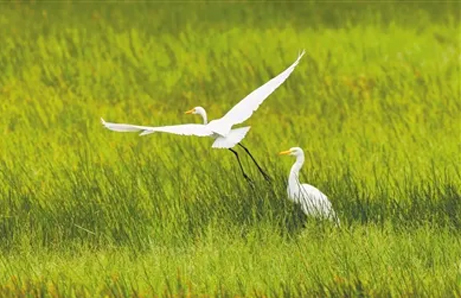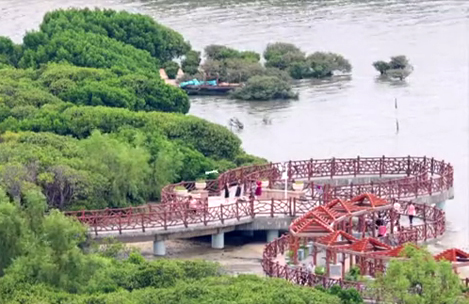Home> Green City
Zhanjiang mangrove forest national nature reserve
The mangrove forest national nature reserve sits in Zhanjiang and covers an area of 20,300 hectares. The mangrove forest covers an area of 7,256 hectares, the largest in the Chinese mainland, with the most varieties and the largest density. The reserve aims to protect tropical mangrove forest wetlands ecosystem and biodiversity, including mangrove forest resources, nearby beaches, water and wild animals. The reserve made the Ramsar Convention (Convention on Wetlands of International Importance Especially as Waterfowl Habitat) catalogue in January 2002 and became a key national biodiversity protection area and an important facility for international wetlands ecosystem protection. It was named a national monitoring point for wild animal (birds) epidemic and coastal protection forest.
The reserve has a total of 25 mangrove and semi-mangrove plants in 15 families, and 21 major associated plants in 14 families. It’s home to the most diversified mangrove forests, with Avicennia marina, Aegiceras corniculatum, Rhizophora stylosa, Kandelia candel and Bruguiear gymnorrhiza being the most widely distributed.
Zhanjiang is home to a total of 194 types of birds and one of the most important bird habitats in Guangdong. There are seven types of birds under State protection and 34 types under Guangdong’s protection. The reserve is not only a habitat and breeding place for birds, but also a stopover point and major pass for migrant birds.
In addition, there are a total of 130 types of shellfish in 41 families and 139 kinds of fish in 60 families. There are 20 veneridae species, predominating in the shellfish category, as well as wrinkled clam, Cadulus anguidens, nassariidae and Cassidula nucleus. There are 65 perciformes species in 27 families, predominating in the fish category. A total of 28 shellfishes and 32 fishes have important economic value.

 Print
Print Mail
Mail 5G construction supports Zhanjiang's high-quality development
5G construction supports Zhanjiang's high-quality development
 Acting mayor inspects project construction in Xuwen, Leizhou
Acting mayor inspects project construction in Xuwen, Leizhou Zhanjiang island an "egret paradise"
Zhanjiang island an "egret paradise"  Dancing egrets add vitality to Xiashan
Dancing egrets add vitality to Xiashan